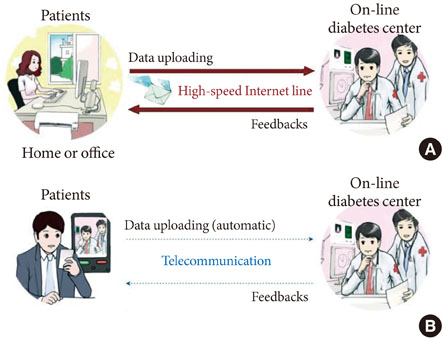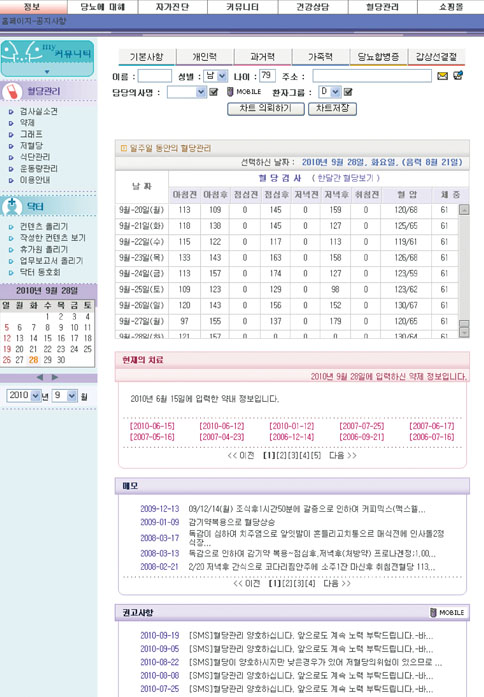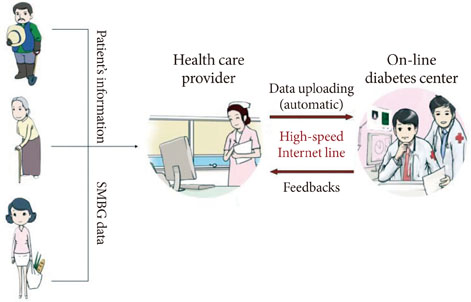Korean Diabetes J.
2010 Oct;34(5):267-273. 10.4093/kdj.2010.34.5.267.
Ubiquitous Diabetes Management System via Interactive Communication Based on Information Technologies: Clinical Effects and Perspectives
- Affiliations
-
- 1Department of Endocrinology, Seoul St. Mary's Hospital, The Catholic University of Korea College of Medicine, Seoul, Korea. yoonk@catholic.ac.kr
- 2The Catholic Institute of Ubiquitous Health Care, The Catholic University of Korea, Seoul, Korea.
- KMID: 2029883
- DOI: http://doi.org/10.4093/kdj.2010.34.5.267
Abstract
- New diabetes management systems based on interactive communication have been introduced recently, accompanying rapid advances in information technology; these systems are referred to as "ubiquitous diabetes management systems." In such ubiquitous systems, patients and medical teams can communicate via Internet or telecommunications, with patients uploading their glucose data and personal information, and medical teams sending optimal feedback. Clinical evidence from both long-term and short-term trials has been reported by some researchers. Such systems appear to be effective not only in reducing the levels of HbA1c but also in stabilizing glucose control. However, most notably, evidence for the cost-effectiveness of such a system should be demonstrated before it can be propagated out to the general population in actual clinical practice. To establish a cost-effective model, various types of clinical decision supporting software designed to reduce the labor time of physicians must first be developed. A number of sensors and devices for monitoring patients' data are expected to be available in the near future; thus, methods for automatic interconnections between devices and web charts were also developed. Further investigations to demonstrate the clinical outcomes of such a system should be conducted, hopefully leading to a new paradigm of diabetes management.
Keyword
MeSH Terms
Figure
Cited by 2 articles
-
Clinical Effects of Remote Glucose Monitoring and Patient-Centered Education Platform for Patients with Diabetes
Yeoree Yang, Jae-Hyoung Cho
J Korean Diabetes. 2020;21(4):204-210. doi: 10.4093/jkd.2020.21.4.204.Current Clinical Status of Telehealth in Korea: Categories, Scientific Basis, and Obstacles
Hun-Sung Kim, Hyunah Kim, Suehyun Lee, Kye Hwa Lee, Ju Han Kim
Healthc Inform Res. 2015;21(4):244-250. doi: 10.4258/hir.2015.21.4.244.
Reference
-
1. Yoon KH, Lee JH, Kim JW, Cho JH, Choi YH, Ko SH, Zimmet P, Son HY. Epidemic obesity and type 2 diabetes in Asia. Lancet. 2006. 368:1681–1688.2. Chan JC, Malik V, Jia W, Kadowaki T, Yajnik CS, Yoon KH, Hu FB. Diabetes in Asia: epidemiology, risk factors, and pathophysiology. JAMA. 2009. 301:2129–2140.3. UK Prospective Diabetes Study (UKPDS) Group. Intensive blood-glucose control with sulphonylureas or insulin compared with conventional treatment and risk of complications in patients with type 2 diabetes (UKPDS 33). Lancet. 1998. 352:837–853.4. The Diabetes Control and Complications Trial Research Group. The effect of intensive treatment of diabetes on the development and progression of long-term complications in insulin-dependent diabetes mellitus. N Engl J Med. 1993. 329:977–986.5. Ohkubo Y, Kishikawa H, Araki E, Miyata T, Isami S, Motoyoshi S, Kojima Y, Furuyoshi N, Shichiri M. Intensive insulin therapy prevents the progression of diabetic microvascular complications in Japanese patients with non-insulin-dependent diabetes mellitus: a randomized prospective 6-year study. Diabetes Res Clin Pract. 1995. 28:103–117.6. Koro CE, Bowlin SJ, Bourgeois N, Fedder DO. Glycemic control from 1988 to 2000 among U.S. adults diagnosed with type 2 diabetes: a preliminary report. Diabetes Care. 2004. 27:17–20.7. Liebl A, Mata M, Eschwege E. ODE-2 Advisory Board. Evaluation of risk factors for development of complications in type II diabetes in Europe. Diabetologia. 2002. 45:S23–S28.8. Chuang LM, Tsai ST, Huang BY, Tai TY. Diabcare-Asia 1998 Study Group. The status of diabetes control in Asia: a cross-sectional survey of 24 317 patients with diabetes mellitus in 1998. Diabet Med. 2002. 19:978–985.9. Cho JH, Chang SA, Kwon HS, Choi YH, Ko SH, Moon SD, Yoo SJ, Song KH, Son HS, Kim HS, Lee WC, Cha BY, Son HY, Yoon KH. Long-term effect of the Internet-based glucose monitoring system on HbA1c reduction and glucose stability: a 30-month follow-up study for diabetes management with a ubiquitous medical care system. Diabetes Care. 2006. 29:2625–2631.10. Kwon HS, Cho JH, Kim HS, Song BR, Ko SH, Lee JM, Kim SR, Chang SA, Kim HS, Cha BY, Lee KW, Son HY, Lee JH, Lee WC, Yoon KH. Establishment of blood glucose monitoring system using the internet. Diabetes Care. 2004. 27:478–483.11. Smith KE, Levine BA, Clement SC, Hu MJ, Alaoui A, Mun SK. Impact of MyCareTeam for poorly controlled diabetes mellitus. Diabetes Technol Ther. 2004. 6:828–835.12. McMahon GT, Gomes HE, Hickson Hohne S, Hu TM, Levine BA, Conlin PR. Web-based care management in patients with poorly controlled diabetes. Diabetes Care. 2005. 28:1624–1629.13. McCoy MR, Couch D, Duncan ND, Lynch GS. Evaluating an internet weight loss program for diabetes prevention. Health Promot Int. 2005. 20:221–228.14. McKay HG, King D, Eakin EG, Seeley JR, Glasgow RE. The diabetes network internet-based physical activity intervention: a randomized pilot study. Diabetes Care. 2001. 24:1328–1334.15. Harno K, Kauppinen-Makelin R, Syrjalainen J. Managing diabetes care using an integrated regional e-health approach. J Telemed Telecare. 2006. 12:Suppl 1. 13–15.16. Farmer AJ, Gibson OJ, Dudley C, Bryden K, Hayton PM, Tarassenko L, Neil A. A randomized controlled trial of the effect of real-time telemedicine support on glycemic control in young adults with type 1 diabetes (ISRCTN 46889446). Diabetes Care. 2005. 28:2697–2702.17. Cho JH, Lee HC, Lim DJ, Kwon HS, Yoon KH. Mobile communication using a mobile phone with a glucometer for glucose control in type 2 patients with diabetes: as effective as an Internet-based glucose monitoring system. J Telemed Telecare. 2009. 15:77–82.18. Yoo HJ, Park MS, Kim TN, Yang SJ, Cho GJ, Hwang TG, Baik SH, Choi DS, Park GH, Choi KM. A Ubiquitous Chronic Disease Care system using cellular phones and the internet. Diabet Med. 2009. 26:628–635.19. von Sengbusch S, Muller-Godeffroy E, Hager S, Reintjes R, Hiort O, Wagner V. Mobile diabetes education and care: intervention for children and young people with type 1 diabetes in rural areas of northern Germany. Diabet Med. 2006. 23:122–127.20. Yoon KH, Cho JH, Kwon HS, Lee JH, Park YM, Lee WC, Cha BY, Son HY. Effect of the Internet-based glucose monitoring system (IBGMS) connected with personal digital assistance (PDA) in rural health subcenter. Paper presented at: 6th Annual Diabetes Technology Society Meeting. 2006 Nov 2-4; Atlanta, GA, USA.21. Cho JH, Lee JH, Oh JA, Kang MJ, Choi YH, Kwon HS, Chang SA, Cha BY, Son HY, Yoon KH. Complication reducing effect of the information technology-based diabetes management system on subjects with type 2 diabetes. J Diabetes Sci Technol. 2008. 2:76–81.22. Cho JH, Yoon KH. Economic impact of the information technology-based diabetes management system on type 2 diabetes: a key for solving world's big problem. Paper presented at: American Diabetes Association 67th Scientific Sessions. 2007 Jun 22-26; Chicago, IL, USA.23. Johnson FR, Manjunath R, Mansfield CA, Clayton LJ, Hoerger TJ, Zhang P. High-risk individuals' willingness to pay for diabetes risk-reduction programs. Diabetes Care. 2006. 29:1351–1356.24. Jackson CL, Bolen S, Brancati FL, Batts-Turner ML, Gary TL. A systematic review of interactive computer-assisted technology in diabetes care. Interactive information technology in diabetes care. J Gen Intern Med. 2006. 21:105–110.25. Cho JH, Yoon KH. Labor saving effect of the semi-automatic response system for diabetes management (SARS-DM) based on the internet. Poster session presented at: American Diabetes Association 68th Scientific Sessions. 2008 Jun 6-10; San Francisco, CA, USA.26. Rossi MC, Nicolucci A, Di Bartolo P, Bruttomesso D, Girelli A, Ampudia FJ, Kerr D, Ceriello A, Mayor Cde L, Pellegrini F, Horwitz D, Vespasiani G. Diabetes Interactive Diary: a new telemedicine system enabling flexible diet and insulin therapy while improving quality of life: an open-label, international, multicenter, randomized study. Diabetes Care. 2010. 33:109–115.27. Ralston JD, Revere D, Robins LS, Goldberg HI. Patients' experience with a diabetes support programme based on an interactive electronic medical record: qualitative study. BMJ. 2004. 328:1159.
- Full Text Links
- Actions
-
Cited
- CITED
-
- Close
- Share
- Similar articles
-
- Perspectives of "Ubiquitous Health Care System" for Diabetes Management
- Mobile Computing: Technologies and Services
- Diabetes Management System Based on Ubiquitous Healthcare
- Design and Implementation of RFID Application System for Hospital Information System
- Design and Implementation of Pulse-Diagnosis Ontology in Ubiquitous Computing Environment




